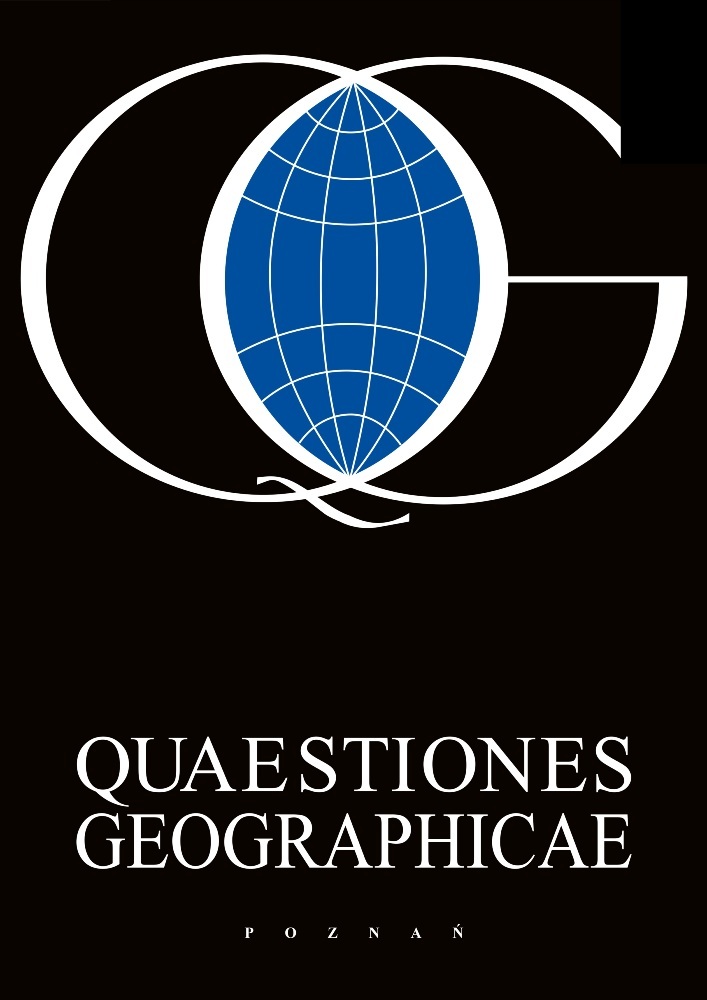Abstract
This report analyses significant hailstorms that occurred in Poland during 2012. The number of reports, derived from the European Severe Weather Database with the hail diameter over or equal 2 cm, were analyzed with respect to their frequency in individual months, time of the day, intensity and spatial distribution. Analyzed cases were divided for hail with diameter less than 4 cm and greater or equal 4 cm. Accompanying conditions were examined by synoptic analysis charts derived from Deutscher Wetterdienst. The total number of 121 large hail cases gave 26 days with this phenomenon. The period of their occurrence extended from April to August reaching peak in July. Above 60% of all events were reported between 1500 and 1800 UTC. Most of them were associated with cold front and squall line features, usually with the south-western warm and moist air mass influx.
References
Bielec-Bąkowska Z., 2002. Zróżnicowanie przestrzenne i zmienność wieloletnia występowania burz w Polsce 1949-1998, Wydawnictwo Uniwersytetu Śląskiego.
Bielec-Bąkowska Z., 2010. Występowanie gradu w Polsce w świetle cyrkulacji atmosfery w latach 1966-2006. In: T. Ciupa, R. Suligowski (eds), Woda w badaniach geograficznych. Kielce: 359-374.
Browning K.A., 1964. Airflow and precipitation trajectories within severe local storms which travel to the right of the winds. Journal of the Atmospheric Sciences 22: 664-668.
Changnon S.A., Changnon D., Hilberg S.D., 2009. Hailstorms across the nation. An atlas about hail and its damages, Illinois State Water Survey.
Cotton W.R., van den Heever S., Jirak I., 2003. Conceptual Models of Mesoscale Convective Systems: Part 9. Colorado State University.
Craven J.P., Brooks H.E., 2004. Baseline climatology of sounding derived parameters associated with deep moist convection. National Weather Digest 28: 13-24.
Dessens H., 1960. Severe hailstorms are associated with very strong winds between 6000 and 12,000 meters. Physics of Precipitation, Geophysical Monograph, Washington, D.C., American Geophysical 5: 333-338.
Doswell III C.A., Burgess D.W., 1993. Tornadoes and tornadic storms: a review of conceptual models. In: H. Church et al. (ed.), The Tornado: Its Structure, Dynamics, Prediction, and Hazards. American Geophysical. Union 79: 161-172.
Dotzek N., Groenemeijer P.H., Feuerstein B., Holzer A.M., 2009. Overview of ESSL’s severe convective search using the European Severe Weather Database ESWD. Atmospheric Research 93: 575-586.
Folland C.K., T.R. Karl, J.R. Christy, R.A. Clarke, G.V. Gruza, J. Jouzel, M.E. Mann, J. Oerlemans, M.J. Salinger and S.-W. Wang, 2001. Observed Climate Variability and Change. In: Climate Change 2001: The Scientific Basis. Contribution of Working Group I to the Third Assessment Report of the Intergovernmental Panel on Climate Change. Cambridge University Press, Cambridge, United Kingdom and New York, NY, USA.
Galway J.G., 1956. The lifted index as a predictor of latent instability, Bulletin of American Meteorological Society 37: 528-529.
Groenemeijer P.H., Dotzek N., Stel F., Brooks H.E., Doswell C.A., Elsom D.M., Giaiotti D.B., Gilbert A., Holzer A.M., Meaden G.T., Salek M., Teittinen J., 2004. A data format for severe weather events to be used in Europe. 3rd European Conference on Severe Storms, León, Spain, 9-12 Nov.
Groenemeijer P.H., van Delden A., 2007. Sounding-derived parameters associated with large hail and tornadoes in the Netherlands. Atmospheric Research 83: 473-487.
Hart J.A., Korotky W., 1991. The SHARP workstation v1.50 users guide. National Weather Service, NOAA, U.S. Departmentof Commerce: 30 pp. [Available from NWS Eastern Region Headquarters, 630 Johnson Ave., Bohemia, NY 11716].
Knight C. A., Knight N.C., 2001. Hailstorms. In Severe Convective Storms. In: American Meteorological Society Doswell III (ed.), AMS Monograph 28(50): 223-254.
Kolendowicz L., 2006. The influence of synoptic situations on the occurrence of days with 294 thunderstorms during a year in the territory of Poland. International Journal of Climatology 26: 1803-1820.
Koźmiński Cz., 1964. Geograficzne rozmieszczenie większych burz gradowych zanotowanych na obszarze Polski w latach 1946-1956. Przegląd Geograficzny 36: 87-102.
Kunz M., Sander J., Kottmeier Ch., 2009. Recent trends of thunderstorm and hailstorm frequency and their relation to atmospheric characteristics in southwest Germany, International Journal 29: 2283-2297.
Miller R.C, 1967. Notes on analysis and severe storm forecasting procedures of the Military Weather Warning Center. Technical Report 200, AWS, USAF.
Morel C., Senesi S., 2002. A climatology of mesoscale convective systems over Europe using satellite infrared imagery. II: Characteristics of European mesoscale convective systems, Quarterly Journal of the Royal Meteorological Society 128(584): 1973-1995.
Sioutas M.V., Flocas H.A., 2003. Hailstorms in Northern Greece: synoptic patterns and thermodynamic environment. Theoretical and Applied Climatology 75: 189-202.
Sioutas M.V., Meaden T., Webb J.D.C., 2009. Hail frequency and intensity in northern Greece. Atmospheric Research 93: 526-533.
Suwala K., 2012. The influence of atmospheric circulation on the occurrence of hail in the North German Lowlands.
Theoretical and Applied Climatology. 112(3-4): 363-373.
Taszarek M., Kolendowicz L., 2013. Sounding-derived parameters associated with tornado occurrence in Poland and Universal Tornadic Index. Atmospheric Research 134: 186-197.
Tuovinen J.-P., Punkka A.-J., Rauhala J. Hohti H., Schultz D.M., 2009. Climatology of Severe Hail in Finland: 1930-2006, Monthly Weather Review 137(7): 2238-2249.
Zinkiewicz W., Michna E., 1955. Częstość występowania gradu w woj. lubelskim w zależności od warunków fizjograficznych. Annales UMCS, Sectio B, 10(5): 224-267.
License
© Faculty of Geographical and Geological Sciences, Adam Mickiewicz University.
This work is licensed under the Creative Commons Attribution-NonCommercial-NoDerivatives 3.0 License.
